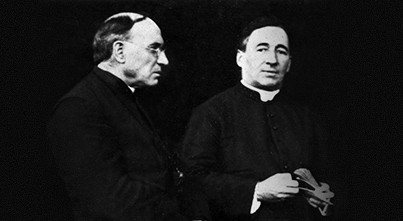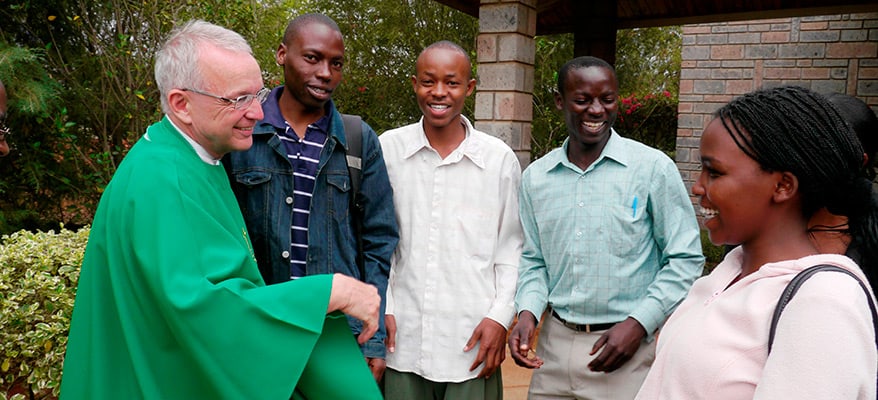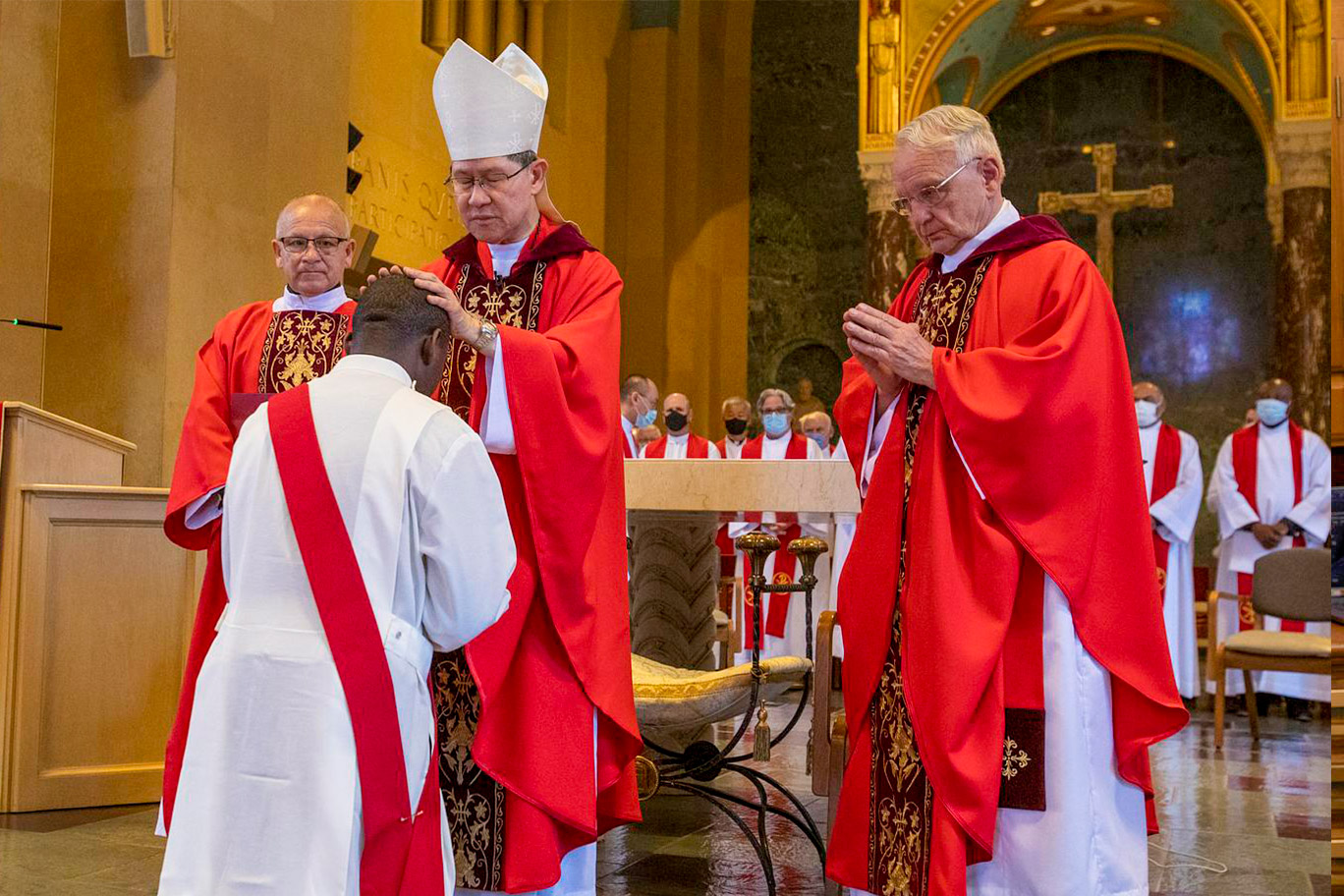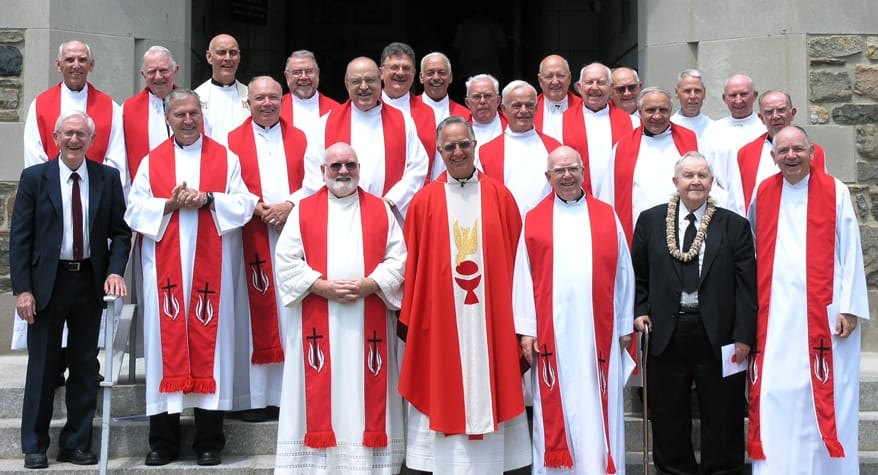
by Maryknoll Society | Jun 2, 2014 | Call to Mission, Events & Celebrations, Notable Maryknollers
On Sunday, June 29, the Maryknoll Society will commemorate anniversaries of ordination to the priesthood or Final Oath as a Maryknoll Brother for 31 jubilarians. Ceremonies will be held at the Maryknoll Mission Center in Ossining, New York.
A number of the Maryknoll jubilarians have shared information about their work in mission in Africa, Asia, Latin America and the U.S. During the second half of June and continuing through the summer, all of the 2014 Maryknoll jubilarians will be celebrated in the Maryknoll Museum of Living Mission located in the Maryknoll Mission Center.
(more…)
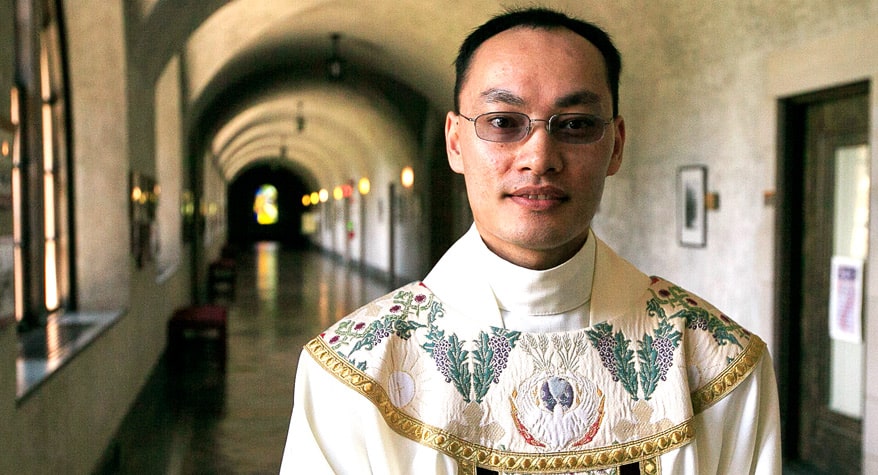
by Maryknoll Society | Jun 2, 2014 | Call to Mission, Events & Celebrations
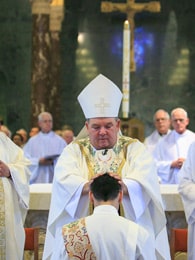 Father Lam Minh Hua, M.M., originally from Vietnam and now from Tacoma, Washington, is the newest Maryknoll Society priest. Father Hua, 28, was ordained into the Maryknoll Fathers and Brothers on Saturday, May 31, 2014 at the Maryknoll Society Mission Center in Ossining, New York.
Father Lam Minh Hua, M.M., originally from Vietnam and now from Tacoma, Washington, is the newest Maryknoll Society priest. Father Hua, 28, was ordained into the Maryknoll Fathers and Brothers on Saturday, May 31, 2014 at the Maryknoll Society Mission Center in Ossining, New York.
The Mass of Ordination at Maryknoll’s Queen of Apostles Chapel was celebrated by His Excellency Archbishop Bernard Anthony Hebda, coadjutor archbishop of the Archdiocese of Newark, New Jersey. Maryknoll Superior General Father Edward M. Dougherty was a concelebrant along with more than 50 priests from the Maryknoll Society and other religious groups.
Later that same day, Father Hua received his missionary crucifix at the Maryknoll Sending Ceremony that presents Maryknoll missioners to the world. After the summer, he will be assigned to serve in mission in the Africa region. Father Hua hopes to join three other Maryknoll priests who already serve in mission in South Sudan.
Father Hua celebrated his first Mass at Maryknoll’s Queen of Apostles Chapel on Sunday, June 1. During June, he also celebrated Mass in English and Vietnamese in his home parish.
Learning About Maryknoll
Father Hua was born into a Catholic family in the hamlet of LaNang on the outskirts of the eastern coastal province of Da Nang in Vietnam. His parents were rice farmers. Years earlier, Father Hua’s own father had been a seminarian. But, this path ended during Vietnam’s war. The elder Hua served on the side of South Vietnam and became a prisoner of the north.
Upon receiving permission 21 years ago to emigrate to the U.S., the family, which included Father Hua’s younger brother, Vien, arrived in the Archdiocese of Seattle and settled in Tacoma. As a teenager, Father Hua volunteered in his local parish and learned about the work of missionaries who came to the U.S. during the 1800s. Seeing a copy of Maryknoll magazine, he also learned about the Maryknoll Fathers and Brothers and its work in foreign mission.
“The stories in the magazine motivated me to learn more,” said Father Hua. “As I learned more about Maryknoll, I also learned more about my own vocational calling. Since I went through the public school system all my life until college, I depended on weekly religious education and my church life to foster my faith, wherein I found strength through being an ‘active’ Christian.”
While completing his studies at Saint Xavier University in Chicago, earning a degree in philosophy with minors in history and religion, Father Hua participated in retreats and visited a Maryknoll mission in Cambodia. He witnessed outreach to people with AIDS in a program managed by Father James Noonan, M.M.
Soon after, while completing a master of divinity degree with a concentration in world mission at the Catholic Theological Union in Chicago, Father Hua spent two years in Tanzania to learn Swahili. While there, he witnessed and participated in the mission work in Musoma of the late Father Ramon McCabe, M.M.
Building A Church
 While in Tanzania, at a parish on the outskirts of Dar es Salaam, Father Hua was encouraged to venture out on his own by Father John Waldrep, M.M. Father Hua traveled to a village far from the regular parish. With his encouragement, the people cleared an overgrown plot of land in the middle of a field close to the village and then began bringing poles, tarps, sticks and wood to build their own church.
While in Tanzania, at a parish on the outskirts of Dar es Salaam, Father Hua was encouraged to venture out on his own by Father John Waldrep, M.M. Father Hua traveled to a village far from the regular parish. With his encouragement, the people cleared an overgrown plot of land in the middle of a field close to the village and then began bringing poles, tarps, sticks and wood to build their own church.
“Every Sunday, when I got there, I’d see they’d added more poles, more tarp. It was a really beautiful way to pray, out in the middle of nature. They were people of great faith. They came every week, bringing their own chairs and mats. The beauty of this experience is that because I said, ‘OK, let’s do it,’ they were able to build that little outpost church. If I hadn’t gone out there, they would have had no one to say ‘yes.’ That’s all they were waiting for. They were all ready.”
As the newest priest in the Maryknoll Society, Father Hua now is ready to begin his work in mission.
To learn more about Father Lam Minh Hua, please read the article “The Road to God” that appears in the May/June 2014 issue of Maryknoll magazine.
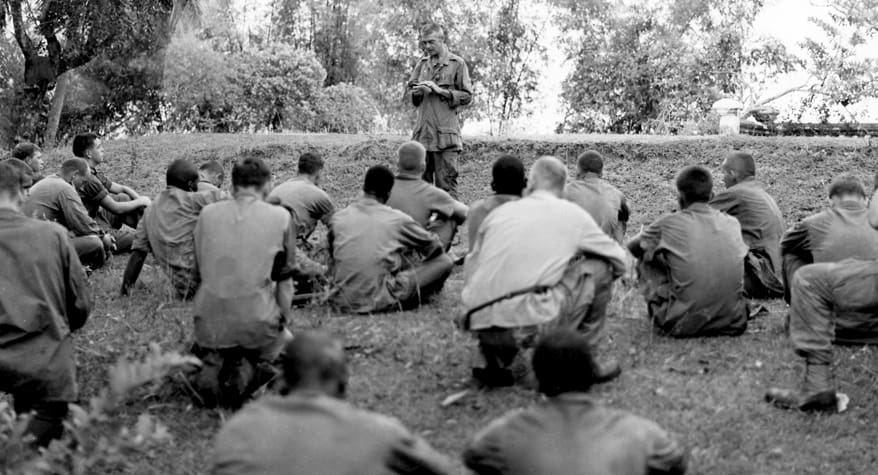
by Maryknoll Society | Sep 6, 2012 | Call to Mission, Notable Maryknollers
SPECIAL TO THE ADVANCE
(article originally appeared in the Staten Island Advance – www.silive.com)
STATEN ISLAND. N.Y. – There are some people who possess an extraordinary singleness of purpose uninhibited by adversity or misfortune of any kind. They have a faith that is so dominating as to provide the will to resist them being deterred from what they see as their mission in life.
Such a person was Vincent Robert Capodanno.
On Sept. 4, 1967, nearly 45 years ago, Father Capodanno was killed on a battlefield in Vietnam living out his purpose in this life — protecting, comforting and indeed, living as one of them, the United States Marines, in battle and under fire.
He risked his life a hundred times over in fulfilling his mission for God on this Earth and did so with courage and dignity and passion.
Vincent Capodanno was born on Feb. 13, 1929, in Mariners Harbor, to an Italian-American family, both his parents having emigrated from the town of Gaeta in Italy. It was here on Staten Island that the remarkable story of one exceptional human being began.
An early calling was his blessing and though he never expressed it to his family, it became evident to them particularly as they watched Vince’s development as a priest and a missionary.
Vince graduated from PS 44 in January 1943. Always fastidious, his classmates voted him best looking and best dresser. He attended Curtis High School, where he served as a class officer and worked after school at a local drug store. A devout Catholic, he attended daily mass while working as a clerk at the Pearl Insurance Company on Maiden Lane in Manhattan, following graduation in 1947.
THE CALLING
He also attended night classes at Fordham University. It was during a retreat young Capodanno attended that he confided to his friend William Richter his great desire to become a priest.
He was further drawn to foreign mission work and applied to the seminary of the Maryknoll Missions in Ossining, N.Y. He would spend the next nine years in study and preparation for his calling.
Father Capodanno was ordained on June 14, 1958, with his whole family in attendance. He received ordination from Cardinal Francis Spellman, who would also be his superior in the Chaplain Corps and would later say the funeral Mass for the chaplain.
The first assignment for the new priest was in Taiwan, where he served for six years. Sadly, his mother, Rachel, was in failing health at the time of his departure for the East, making the separation all the more painful for both of them. On Feb. 27, 1961, she passed away and Father Vincent was not able to return home for her funeral.
He was further troubled by the knowledge that his mother had worried about his serving so far away and in a foreign country.
Reassigned to Hong Kong in 1965, it was at this time that Father Vincent made an application to join the Chaplain Corps. His restlessness and the desire to do more prompted his decision. Furthermore, he chose the Marines. It was his desire to “go where he was needed.”
After serving 11 months in Vietnam, he insisted upon extending his tour by six more months. His work of living with and sharing the burdens of the combat Marines was not yet completed. His request was ultimately granted in the summer of 1967.
The decisions — to become a priest, to enter the missions, to serve as a combat chaplain — were great ones, yet seemed to flow from Father Vincent as the natural course of his life and purpose took shape within him. He, indeed, became a Marine. He lived with them, worked with them, comforted them under dire stress and in the end, died with them.
THE LAST FIGHT
On Sunday, Sept. 3, 1967, Father Vincent celebrated his last Mass in the village of An Hoa, south of Da Nang. A corporal who was an altar server that morning remembered the sky as a beautiful blue, and the sun bright.
The next morning, Operation Swift began. A standard “search-and-destroy” mission turned into a sky lit up with enemy mortar fire. Father Vincent arrived on the scene with companies K and M.
As the fighting intensified through the morning hours, Father Vincent was seen running from one fallen Marine to another, comforting and attending the wounded, administering the last rites of the church to the dying.
He felt the pain and suffering of “his Marines,” the men he called his parishioners. With no regard for his own welfare, he continued to perform what he considered his duty.
Out-numbered as they were, the 5th Marines suffered many casualties. Father Vincent was hit during one of his forays — shrapnel wounds to his arms, hand and leg — but refused medical attention. He instructed the corpsman to attend to the other wounded first.
As the battle persisted into the early evening, a enemy soldier with a machine gun had two Marines pinned down and Father Vincent went to their aid.
One of them, Cpl. Tancke, said: “He actually jumped in front of the machine gun.” Two bursts of fire hit the chaplain. He received 27 bullet wounds as he and corpsman Leal were killed together. One of the Marines who retrieved the chaplain’s body reported that he lay with his right hand over his left breast pocket and “had a smile on his face.”
Father Capodanno’s life is revealed in honor and intensity by Father Daniel L. Mode in his biography, “The Grunt Padre.”
‘SERVANT OF GOD’
Memorials to The Grunt Padre abound. At least seven chapels have been dedicated to his memory. On Dec. 29, 1971, the Navy named the Escort Ship DE-1093 the USS Capodanno; among the art work inspired by Father Capodanno is the oil painting by Staten Island artist Gregory Perillo as part of his 40 works dedicated to the warriors of Vietnam.
Of course, Seaside Boulevard was renamed Father Capodanno Boulevard. The list is far to long for this space.
Although he did not pursue such honors, Father Capodanno was awarded the Vietnamese Cross of Gallantry with Silver Star and the Navy Bronze Cross for meritorious service during six combat operations.
He received the Purple Heart posthumously and on Jan. 7, 1969, at the Washington Navy Yard Sail Loft, James Capodanno, on behalf of the Capodanno family, accepted the Congressional Medal of Honor for his brother.
Most significant are the steps being taken by the Vatican in Rome to bestow sainthood in the Roman Catholic Church upon this man.
There are three stages to the process and Father Capodanno has achieved stage one — named a “Servant of God.” Earlier this year, a Vatican representative visited the Island to interview those who knew him as part of the investigation for stage two.
Whether or not the canonization is accomplished, Father Capodanno is surely no less than a saint to all who knew him. It was said by those who served with him in battle that he was a man “imbued with the spirit of Christ …”
Said Navy Chaplain Joseph F. Cloonan, serving in Vietnam, in a statement published under the title “A Bell For Capodanno”:
“But every once in a while, like a flash of heat lightning, the self-giving of someone like Father Capodanno illuminates the mystery of nobility in an ignoble world.”
Another colleague, Father Thomas J. Woolten, wrote of the Marines and Father Vincent after his death: “Those Grunts saw Christ when they saw Vince.”
He could not have been far off the mark.
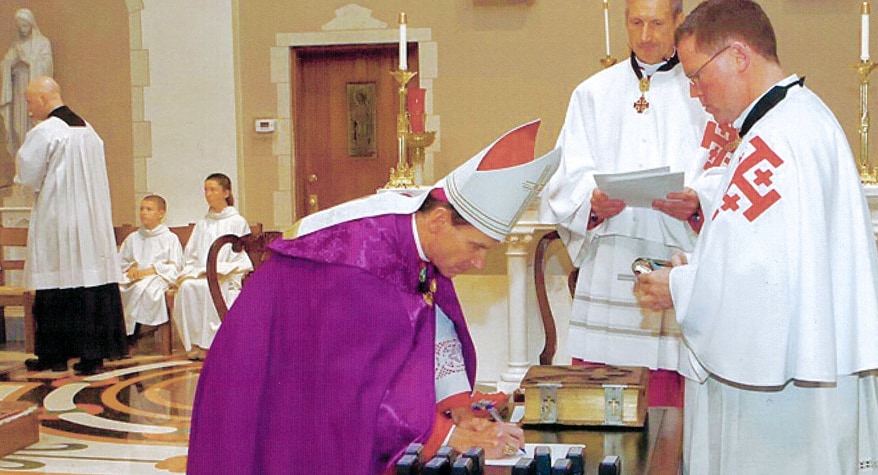
by Maryknoll Society | Apr 3, 2012 | Notable Maryknollers
Lumina News – Wednesday, March 14, 2012
(Supplied photo courtesy of Rich Cox / Catholic Diocese of Raleigh)
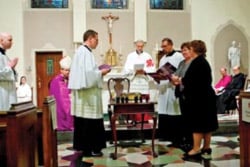 Bishop Michael Burbidge, from left; Father James F. Garneau, Episcopal Delegate for the Cause; Msgr. Jerry M. Sherba, Chancellor of the Diocese who administered the oaths; Father Ja Van Saxon, Promoter of Justice; Angela Godwin Page, Actual Notary and Maureen Foster, Adjunct Notary, gather on Friday, March 9, in Raleigh for a prayer service and to take an oath, beginning the diocesan phase of the Cause for Beatification and Canonization of Father Thomas Frederick Price.
Bishop Michael Burbidge, from left; Father James F. Garneau, Episcopal Delegate for the Cause; Msgr. Jerry M. Sherba, Chancellor of the Diocese who administered the oaths; Father Ja Van Saxon, Promoter of Justice; Angela Godwin Page, Actual Notary and Maureen Foster, Adjunct Notary, gather on Friday, March 9, in Raleigh for a prayer service and to take an oath, beginning the diocesan phase of the Cause for Beatification and Canonization of Father Thomas Frederick Price.
The Catholic Diocese of Raleigh has officially opened the diocesan phase of the Cause for Beatification and Canonization of North Carolina’s first native Catholic priest.
Tribunal members met Friday, March 9, in Raleigh for a prayer service and to take an oath as they begin a formal study of Father Thomas Frederick Price, who was born in Wilmington in 1860.
The tribunal’s historical and theological commissions will study Father Price’s writings and records about his life and listen objectively to witnesses who may have knowledge of his work or reputation, Father James F. Garneau, pastor of St. Mary of the Angels Catholic Church in Mount Olive, said Monday, March 12.
Garneau, Episcopal delegate for the cause, added they have a list of about 30 witnesses from throughout the country so far.
“We don’t have living witnesses from his time, eyewitnesses,” Garneau said. “But we have people in the next generation, people who knew people who knew Father Price.”
Bishop Michael Burbidge opened the cause at Sacred Heart Cathedral. Among those attending was Edward Price of Clayton, one of Father Price’s descendants.
“He was a fascinating man,” Edward Price said Monday, March 12, by telephone.
“Imagine having a conversation with someone and saying, ‘By the way, my fourth cousin is a saint.’ I find that remarkable,” he added when asked about his ancestor possibly being declared a saint someday. “How many people on this earth can say that?”
Price established the Nazareth Community orphanage in Raleigh, co-founded the Maryknoll Fathers and Brothers mission society in New York with Father James A. Walsh and served on Maryknoll’s first foreign mission in 1918. He suffered an infected appendix while in China and died in 1919.
A family connection was made when Edward Price saw an issue of NC Catholics magazine last year with Father Price on the cover. He recalled his father telling him about a famous priest from North Carolina they might be related to.
“I mailed the copy to my father and that pretty much got the ball rolling,” Edward Price said.
Family genealogical research helped confirm that connection, and the family contacted the bishop and visited Maryknoll, said Edward Price’s father, Carl Price of Red Bank, N.J.
Carl Price, who grew up in Brooklyn, N.Y., said his father had mentioned having had a cousin from North Carolina who co-founded the Maryknoll Society.
“We kind of knew this as a fact of family history but…we never took any action upon it,” Carl Price, 82, said during a telephone interview Thursday, March 8.
The Price family came to the United States from Wales and settled in Wilmington, where some family members were buried at Oakdale Cemetery, he said.
Father Price’s father — Alfred Lanier Price, editor of the Wilmington Daily Journal — had a brother, William, who was Carl Price’s great-grandfather. Father Price was editor for a magazine about the Catholic faith called Truth.
“It’s just such a wonderful, wonderful thing,” Carl Price said. “The more I’ve learned through the genealogy that there is a blood connection here, it’s something I never expected. And I’m sure my father, if he were alive, he would be astounded about this too.”
“It’s such an honor,” he added. “I’m overwhelmed and I feel very blessed by this connection.”
The tribunal will examine if Father Price’s life demonstrated heroic virtue and will study reports of any miracles people believe are from his intercession or prayers.
“We’re not looking to jump to conclusions,” Garneau said. “The church is deliberate on this so if a declaration is made there’s a certain assuredness we can point to, even among nonbelievers.”
Father Price, called the “Tar Heel Apostle,” is credited with spreading Catholicism throughout North Carolina. He belonged to St. Thomas Church in downtown Wilmington, which is now St. Thomas Preservation Hall.
“I hope this beautiful area of our diocese in Wilmington takes great pride, because Father Price, this was where he was born and certainly grew in his own faith,” Burbidge said during a visit to Wilmington on Wednesday, March 7.
Father Price’s legacy includes 39 acres of land near Raleigh remaining from about 400 acres he bought in 1897, which is where the diocese planned to build a new cathedral. The current cathedral seats approximately 320 people and is the nation’s second smallest Catholic cathedral after the one in Juneau, Alaska, the bishop said.
In death Father Price is near two important figures of his life — his body is buried near Walsh’s remains at Maryknoll, while his heart is buried near St. Bernadette’s tomb in France.
When asked why the church recognizes saints, Burbidge said it is a way to provide concrete examples and is similar to honoring respected members of professions.
“We can talk about saintly virtues,” Burbidge said. “But it’s a lot better when you can say, ‘And here is an example, and here are some of the things that this woman or this man did in his or her earthly life. These are obstacles that they faced, and this is how through their holiness that they conquered it.’”
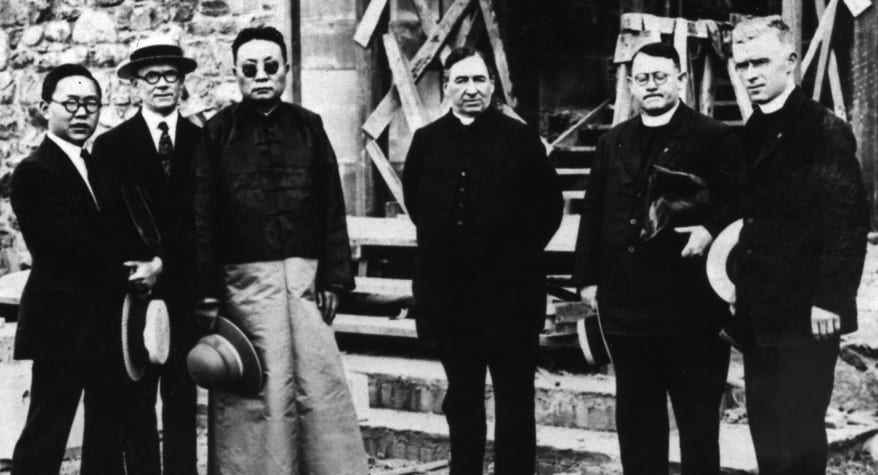
by Maryknoll Society | Nov 16, 2011 | Call to Mission, Events & Celebrations, Notable Maryknollers
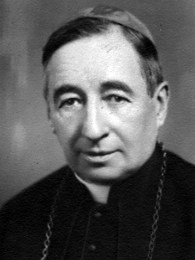 The year commemorating the centennial of the Maryknoll Fathers and Brothers has again been blessed. The Maryknoll Society is rejoicing for the cause for beatification and canonization of Maryknoll Society co-founder Bishop James A. Walsh.
The year commemorating the centennial of the Maryknoll Fathers and Brothers has again been blessed. The Maryknoll Society is rejoicing for the cause for beatification and canonization of Maryknoll Society co-founder Bishop James A. Walsh.
On Wednesday, November 9, 2011 at the Archdiocese of New York in New York City, the cause for beatification and canonization of Bishop Walsh was formally opened by the diocesan tribunal led by Monsignor Douglas Mathers. Receiving official approval from the Vatican to begin, the procedure now is formally in place to pursue the cause for beatification of Bishop Walsh in the Archdiocese of New York.
Attendees at the ceremony included Father Edward M. Dougherty, superior general of the Maryknoll Society who has served the mission of the Church in Africa. All official witnesses took their oaths on the Bible to discharge their respective obligations with integrity and honesty.
The next steps in the process include:
• Obtaining formal witness testimony.
Since few people today actually met Bishop Walsh, who died during 1936, his cause is considered, technically, an “historical” cause. Most evidence will be textual. Witnesses to be called will be faithful Catholics willing to testify as to their belief in Bishop Walsh’s reputation for sanctity and heroic virtue.
A second class of witnesses will be divided into groups of historians and theologians. Historians are charged with gathering and guaranteeing the authenticity of any documentation on the life, works and faith of Bishop Walsh that includes all published and unpublished writings. They will submit reports about his writings along with a biographical sketch. The theologians will examine the papers and then issue reports verifying the integrity of the candidate and absence of any defect of faith and morals.
• Documentation delivered to Rome.
Once the cause is complete at the diocesan level, all documentation will be delivered to Rome for the second phase of the process. Reports and documentation again will be examined. Further documentation, including any possible testimony of miraculous intervention, will be gathered.
• Prayers and inquiries of others.
During the process, anyone interested in the cause of Bishop Walsh is welcome to inquire about him at Maryknoll, offer pertinent faith experience and offer prayers of support of the cause, and, especially, of the mission of the Church to which Bishop Walsh dedicated his life.
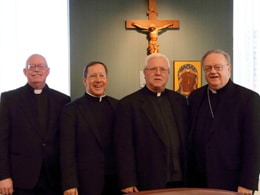
Monsignor Douglas Mathers, second from left, vice chancellor of the archdiocese and episcopal delegate for the cause, joins Auxiliary Bishop Dennis Sullivan, the archdiocese’s vicar general, right; Father Edward M. Dougherty, M.M, superior general of the Maryknoll Fathers and Brothers, second from right; and Father Michael P. Walsh, M.M., member of the historical commission, left, at the swearing-in ceremony for the opening of the sainthood cause of Maryknoll co-founder Bishop James A. Walsh at the Catholic Center in Manhattan on November 9. Photo courtesy of Catholic New York.
Beatification and Canonization Witnesses
• Postulator: Dr. Andrea Ambrosi
• Episcopal Delegate: Reverend Msgr. Douglas J. Mathers
• Promoter of Justice: Reverend Richard Welch C.Ss.R.
• Actual Notary: Maryknoll employee Marie Ray
• Adjunct Notary: Maryknoll employee Maureen Foster
• Copyist: Maryknoll employee Holly E. Brown
• Members of the Historical Commission (3): Reverend Michael P. Walsh, M.M. (who has served the mission of the Church in South China), Alan B. Delozier and Paul F. Gibbons
• Members of the Theological Commission (2): Patrick Hayes and Reverend Mark Francis O’Malley
About Bishop James A. Walsh
James Walsh was born to middle-class parents (James Walsh and Hanna Shea) in Cambridge, Massachusetts, on February 24, 1867. After attending public elementary school, he graduated from Boston College High School with skills in debating and journalism. He attended Boston College but later transferred to Harvard College to study bookkeeping. Studies were completed at St. John’s Seminary in nearby Brighton.
At the seminary, Father Walsh was inspired by a rector, a Sulpician (a society of secular priests founded during 15th century France) whose classmate in Paris, Theophane Venard, had died as a famous martyr in Indochina. A decade after his 1892 ordination at the Cathedral of the Holy Cross, Father Walsh retraced Venard’s steps in France along with those of other French martyrs, and he became convinced that the blood of martyrs is the seed of the church.
Father Walsh served as curate at St. Patrick’s Church in Roxbury until he was appointed diocesan director of the Society for the Propagation of the Faith during 1903. Among his responsibilities was to raise money to support overseas mission, and during this time, he began to develop his vision, a modernized version of mission, for a mature U.S. Church that was eager to fulfill exciting and joyful missionary responsibilities around the world.
Along with the Catholic Foreign Mission Bureau, Father Walsh founded The Field Afar magazine, a monthly publication about the foreign missions of the Catholic Church. Years later, this magazine would become the Maryknoll magazine that continues to be published today (along with its bilingual counterpart Revista Maryknoll) by the Maryknoll Fathers and Brothers.
During 1910, at the 21st Eucharistic Conference in Montreal, Father Walsh shared his vision of U.S. Catholic mission with Father Thomas Frederick Price of North Carolina. Realizing they shared a common call to mission, the urbane Father Walsh and the more rural Father Price collaborated on plans for a mission society within the U.S. Catholic Church. Soon after, the bishops of the United States formally sanctioned the pursuit of their vision to recruit, send and support U.S. missioners around the world.
With this approval, Father Walsh and Father Price traveled to Rome to present their vision of mission. They received the blessing of Pope Pius X on June 29, 1911 (the feast of Saints Peter and Paul), which is the founding day of the Catholic Foreign Mission Society of America that, over the years, has become more well-known as Maryknoll Fathers and Brothers.
Father Walsh was a model priest and a natural leader. He was the first Superior General of the Society, the treasurer, the editor of its publication, rector of the seminary, spiritual director of the Maryknoll Sisters that was formed during 1912, along with master organizer, fundraiser, publicist and overseer of plans and building for the Society. It is difficult to find any aspect of the foundation of Maryknoll that did not benefit from the direction and oversight of Father Walsh.
Father Walsh’s contributions to the Catholic Church in the U.S. and to the growth of mission were celebrated when he was ordained as bishop on June 29, 1933 by Pope Pius XI in Rome. Only a few years later, on April 14, 1936, Bishop Walsh passed away.
Causes for Father Price and Father Capodonno
The cause for beatification and canonization of Bishop Walsh is the third for the Maryknoll Society.
Causes have been established for Maryknoll co-founder Father Thomas F. Price (pending) and for Maryknoll Father Vincent R. Capodanno.
Thomas Price was born in Wilmington, North Carolina, the eighth child of Alfred and Clarissa Bond Price, on August 19, 1860. Having converted to the Catholic faith, his parents raised their children to be devout Catholics in the midst of Southern apathy toward the religion.
During his formative years, Thomas Price was deeply influenced by priests from his Wilmington parish of St. Thomas. With a religious upbringing that included profound understanding of the deep devotion his mother held for the Blessed Virgin Mary, the young Price soon became attracted to the priesthood. Father Price became the first Catholic priest born in North Carolina.
Vincent R. Capodanno was born on February 13, 1929 in Staten Island, New York. During the 1960s, he asked to be reassigned from his Maryknoll mission in Formosa to serve as a U.S. Navy chaplain. He served with a unit of the U.S. Marines in Vietnam and, though mortally wounded during an ambush on September 4, 1967, he continued to administer to others who were injured.
Father Capodanno is the only chaplain to receive the Medal of Honor for service with the Marine Corps. During 2011 in Triangle, Virginia, the Marine Corps Heritage Foundation dedicated the “Sacrifice Window” to Father Capodanno in the Semper Fidelis Memorial Chapel at the National Museum of the Marine Corps.
Watch a video about Bishop Walsh click here.
Watch this same video on Youtube by clicking here.

by Maryknoll Society | Jun 16, 2011 | Aiding Those Most in Need, Call to Mission, Events & Celebrations
Each morning at 7, the Rev. John Hudert can be found on a fertile patch of land at Maryknoll, tending to the rows of cabbage, squash, tomatoes and lettuce that will eventually make their way onto the plates of Westchester’s needy.
(more…)
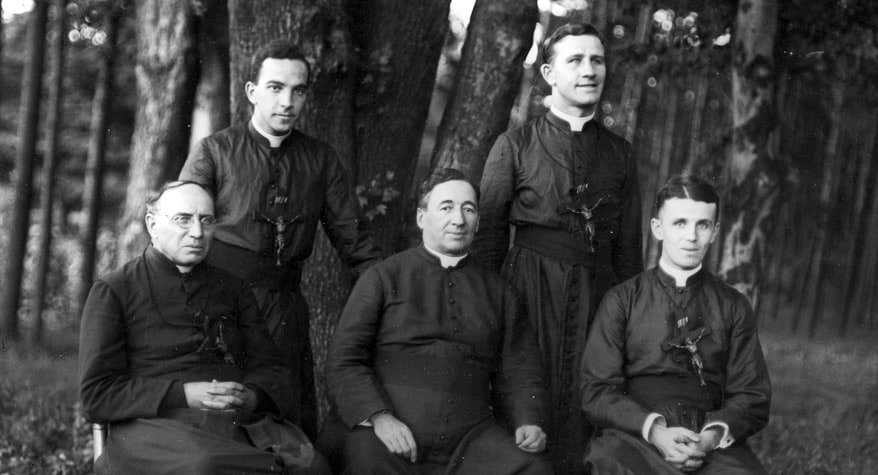
by Maryknoll Society | Jan 7, 2011 | Call to Mission
(article from Faith Magazine Jan/Feb 2011)
by Patricia Marshall
The young faces gazing out from the old black and white photos were calm but expectant. It was hard for me to imagine what they must have been feeling as they embarked on a difficult and potentially dangerous trip. They would probably never see their family and friends again.
These were not the faces of soldiers, but rather of early Maryknoll missionaries, waiting to board a ship that would take them to their new life of service in a foreign land. Their pictures hang in a display on the history of Maryknoll missions in the group’s headquarters in Ossining, N.Y.
This year the Maryknoll Fathers and Brothers, officially named The Catholic Foreign Mission Society of the United States, are celebrating their 100th anniversary. Among those celebrating are Diocese of Erie natives Father Paul Masson from Rouseville, Father Ed Shellito from Erie and Father Tom Egan from Oil City.
Much has changed about mission life over the past century. Travel to places such as Asia or South America took weeks in the early 20th century. Letters written home could take months to arrive, if they made it at all. Today’s flights enable travelers to reach the most distant destinations quickly, and to make visits home. The Internet can provide daily communication with friends and loved ones.
Early missioners were mostly priests and religious. Today there is a growing trend of lay involvement. Individuals or even families serve in missions through lay organizations such as the Maryknoll Mission Association of the Faithful. Retirees are joining the ranks of missionaries. Volunteers can choose short-term or long-term service.
Of course the basics of mission remain the same. Even though today’s missioners have options that would have seemed like unimaginable luxuries to early missionaries, mission life still requires much dedication, hard work and courage. Mission assignments in areas of political unrest or high criminal activity can be extremely dangerous. The rewards of being the bearer of the “Good News” cannot be measured in monetary terms, but still bring a joy that continues to call the faithful to a life of service.
Maryknoll has served people not only abroad, but also here in the United States by educating us about the lives of our brothers and sisters in Christ throughout the world. My own earliest memories of learning about missionaries include the Maryknoll magazines our catechism teachers gave us. These publications still teach students and adults about mission today.
Congratulations to the Maryknoll Fathers and Brothers on 100 years of amazing service. Along with that go my own personal thanks for introducing me to the work that has become so central in my life.
Patricia Marshall directs the Office of Diocesan and International Missions for the Diocese of Erie
Article from page 23 of Faith Magazine – Jan/Feb 2011 www.FAITHerie.com


 Father Lam Minh Hua, M.M., originally from Vietnam and now from Tacoma, Washington, is the newest Maryknoll Society priest. Father Hua, 28, was ordained into the Maryknoll Fathers and Brothers on Saturday, May 31, 2014 at the Maryknoll Society Mission Center in Ossining, New York.
Father Lam Minh Hua, M.M., originally from Vietnam and now from Tacoma, Washington, is the newest Maryknoll Society priest. Father Hua, 28, was ordained into the Maryknoll Fathers and Brothers on Saturday, May 31, 2014 at the Maryknoll Society Mission Center in Ossining, New York. While in Tanzania, at a parish on the outskirts of Dar es Salaam, Father Hua was encouraged to venture out on his own by Father John Waldrep, M.M. Father Hua traveled to a village far from the regular parish. With his encouragement, the people cleared an overgrown plot of land in the middle of a field close to the village and then began bringing poles, tarps, sticks and wood to build their own church.
While in Tanzania, at a parish on the outskirts of Dar es Salaam, Father Hua was encouraged to venture out on his own by Father John Waldrep, M.M. Father Hua traveled to a village far from the regular parish. With his encouragement, the people cleared an overgrown plot of land in the middle of a field close to the village and then began bringing poles, tarps, sticks and wood to build their own church.

 Bishop Michael Burbidge, from left; Father James F. Garneau, Episcopal Delegate for the Cause; Msgr. Jerry M. Sherba, Chancellor of the Diocese who administered the oaths; Father Ja Van Saxon, Promoter of Justice; Angela Godwin Page, Actual Notary and Maureen Foster, Adjunct Notary, gather on Friday, March 9, in Raleigh for a prayer service and to take an oath, beginning the diocesan phase of the Cause for Beatification and Canonization of Father Thomas Frederick Price.
Bishop Michael Burbidge, from left; Father James F. Garneau, Episcopal Delegate for the Cause; Msgr. Jerry M. Sherba, Chancellor of the Diocese who administered the oaths; Father Ja Van Saxon, Promoter of Justice; Angela Godwin Page, Actual Notary and Maureen Foster, Adjunct Notary, gather on Friday, March 9, in Raleigh for a prayer service and to take an oath, beginning the diocesan phase of the Cause for Beatification and Canonization of Father Thomas Frederick Price.
 The year commemorating the centennial of the Maryknoll Fathers and Brothers has again been blessed. The Maryknoll Society is rejoicing for the cause for beatification and canonization of Maryknoll Society co-founder Bishop James A. Walsh.
The year commemorating the centennial of the Maryknoll Fathers and Brothers has again been blessed. The Maryknoll Society is rejoicing for the cause for beatification and canonization of Maryknoll Society co-founder Bishop James A. Walsh.



